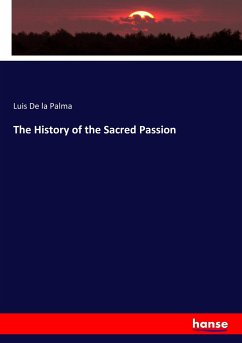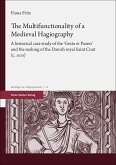Claudia Bolgia
Reclaiming the Roman Capitol: Santa Maria in Aracoeli from the Altar of Augustus to the Franciscans, C. 500-1450
Claudia Bolgia
Reclaiming the Roman Capitol: Santa Maria in Aracoeli from the Altar of Augustus to the Franciscans, C. 500-1450
- Gebundenes Buch
- Merkliste
- Auf die Merkliste
- Bewerten Bewerten
- Teilen
- Produkt teilen
- Produkterinnerung
- Produkterinnerung
This book deals with S. Maria in Aracoeli, the headquarters of the Franciscan Order in Rome, built on the Capitoline hill by the Friar Minors soon after they took over from the Benedictines in the mid-thirteenth century. The approach is to work from the monument as a whole outwards to broader questions concerning the Franciscans' physical and theoretical appropriation of the past, the adaptation of an ancient site by a 'modern' religious order, the relationship between deployment of spolia and Mendicant beliefs, the contribution of the Roman Franciscans to the development of Marian devotion,…mehr
Andere Kunden interessierten sich auch für
![The Image of Aristocracy The Image of Aristocracy]() David CrouchThe Image of Aristocracy168,99 €
David CrouchThe Image of Aristocracy168,99 €![Valkyrie Valkyrie]() Jóhanna Katrín FriðriksdóttirValkyrie13,99 €
Jóhanna Katrín FriðriksdóttirValkyrie13,99 €![The History of the Sacred Passion The History of the Sacred Passion]() Luis De la PalmaThe History of the Sacred Passion31,90 €
Luis De la PalmaThe History of the Sacred Passion31,90 €![The Multifunctionality of a Medieval Hagiography The Multifunctionality of a Medieval Hagiography]() Fiona FritzThe Multifunctionality of a Medieval Hagiography50,00 €
Fiona FritzThe Multifunctionality of a Medieval Hagiography50,00 €![A Short History of Europe A Short History of Europe]() Simon JenkinsA Short History of Europe28,99 €
Simon JenkinsA Short History of Europe28,99 €![A History of Britain in Ten Enemies A History of Britain in Ten Enemies]() Terry DearyA History of Britain in Ten Enemies8,99 €
Terry DearyA History of Britain in Ten Enemies8,99 €![A History of Britain in Ten Enemies A History of Britain in Ten Enemies]() Terry DearyA History of Britain in Ten Enemies13,99 €
Terry DearyA History of Britain in Ten Enemies13,99 €-
-
-
This book deals with S. Maria in Aracoeli, the headquarters of the Franciscan Order in Rome, built on the Capitoline hill by the Friar Minors soon after they took over from the Benedictines in the mid-thirteenth century. The approach is to work from the monument as a whole outwards to broader questions concerning the Franciscans' physical and theoretical appropriation of the past, the adaptation of an ancient site by a 'modern' religious order, the relationship between deployment of spolia and Mendicant beliefs, the contribution of the Roman Franciscans to the development of Marian devotion, and to the transmission and reception of ideas across time and space.
Produktdetails
- Produktdetails
- Verlag: Taylor & Francis
- Seitenzahl: 458
- Erscheinungstermin: 16. Juni 2017
- Englisch
- Abmessung: 251mm x 181mm x 30mm
- Gewicht: 1150g
- ISBN-13: 9781409417613
- ISBN-10: 1409417611
- Artikelnr.: 48573060
- Herstellerkennzeichnung
- Libri GmbH
- Europaallee 1
- 36244 Bad Hersfeld
- gpsr@libri.de
- Verlag: Taylor & Francis
- Seitenzahl: 458
- Erscheinungstermin: 16. Juni 2017
- Englisch
- Abmessung: 251mm x 181mm x 30mm
- Gewicht: 1150g
- ISBN-13: 9781409417613
- ISBN-10: 1409417611
- Artikelnr.: 48573060
- Herstellerkennzeichnung
- Libri GmbH
- Europaallee 1
- 36244 Bad Hersfeld
- gpsr@libri.de
Claudia Bolgia is Senior Lecturer in History of Art at the University of Edinburgh. She has published extensively on medieval Rome and Franciscan Art and Architecture in a range of international peer-reviewed journals. Co-editor, with Rosamond McKitterick and John Osborne, of Rome across Time and Space: Cultural Translation and the Exchange of Ideas, c. 500-1400 (2011), her research has attracted major Fellowships, including Villa I Tatti - The Harvard University Center for Italian Renaissance Studies (2009-10), The British School at Rome (2012-14), CASVA - The Center for Advanced Study in the Visual Arts (2016-17), The Newberry Library (2016-17), and The Leverhulme Trust (2017-18).
Introduction
From Isis to Mary: The Arx and its surroundings from Antiquity to the
Middle Ages
1 Before the Franciscans: The previous churches on the site
- Cunctarum prima quae fuit orbe sita: Literary, documentary, and
epigraphic evidence from the earliest times to the thirteenth century
- From S. Maria in Capitolio to S. Maria in Aracoeli: the title
- Archaeological evidence from the earliest times to the thirteenth century
- The previous churches and their relationship with the Franciscan building
- Early medieval church furniture
- The obelisk
- The cloisters
- Conclusion
2 The Franciscan 'appropriation' of the Arx
- Franciscan foundations in thirteenth- and fourteenth-century Europe
- The Franciscans in Rome and their new headquarters
- The ara coeli
- The monument and its 'meaning'
- The ara coeli 'confessio': Art for the Benedictines or the Franciscans?
- New and old cults before the construction of the new church
3 The New Franciscan Church: Between tradition and innovation
- An architectural analysis of the medieval building
- Nave and aisles
- Transept
- Chapel L9
- Original main chapel
- Façade
- The decoration of the apse and the Franciscan promotion of the legend of
Augustus from Rome to Finland
- Marble workshop: Window tracery
- Transmission and reception of formal ideas: Artistic exchanges between
Rome and England in the thirteenth century
- The magister principalis and the builders
- The deployment of Spolia and Franciscan ideas
- New and old cults in the new Franciscan church: paths for faithful and
pilgrims
4 The 'extended' space of the Franciscan church: S. Maria in Aracoeli as a
lived social and political place
- The 'extended' space of the church exterior
- The original side-entrance and the guardianship of the minors
- Preaching, politics, and religious tribunals
- The 'extended' space of the church interior
- Inner appearance and family chapels
- Burying in the Franciscan church
- Between 'public' and 'private' in the Rome of the popular regime:
Francesco Felici's icon tabernacle and family chapel (1372)
- Beyond Rome: the Legend of Augustus and the Aracoeli icon in Fourteenth-
and early Fifteenth-century Siena
Conclusions
Appendix: chart of intercolumniations
From Isis to Mary: The Arx and its surroundings from Antiquity to the
Middle Ages
1 Before the Franciscans: The previous churches on the site
- Cunctarum prima quae fuit orbe sita: Literary, documentary, and
epigraphic evidence from the earliest times to the thirteenth century
- From S. Maria in Capitolio to S. Maria in Aracoeli: the title
- Archaeological evidence from the earliest times to the thirteenth century
- The previous churches and their relationship with the Franciscan building
- Early medieval church furniture
- The obelisk
- The cloisters
- Conclusion
2 The Franciscan 'appropriation' of the Arx
- Franciscan foundations in thirteenth- and fourteenth-century Europe
- The Franciscans in Rome and their new headquarters
- The ara coeli
- The monument and its 'meaning'
- The ara coeli 'confessio': Art for the Benedictines or the Franciscans?
- New and old cults before the construction of the new church
3 The New Franciscan Church: Between tradition and innovation
- An architectural analysis of the medieval building
- Nave and aisles
- Transept
- Chapel L9
- Original main chapel
- Façade
- The decoration of the apse and the Franciscan promotion of the legend of
Augustus from Rome to Finland
- Marble workshop: Window tracery
- Transmission and reception of formal ideas: Artistic exchanges between
Rome and England in the thirteenth century
- The magister principalis and the builders
- The deployment of Spolia and Franciscan ideas
- New and old cults in the new Franciscan church: paths for faithful and
pilgrims
4 The 'extended' space of the Franciscan church: S. Maria in Aracoeli as a
lived social and political place
- The 'extended' space of the church exterior
- The original side-entrance and the guardianship of the minors
- Preaching, politics, and religious tribunals
- The 'extended' space of the church interior
- Inner appearance and family chapels
- Burying in the Franciscan church
- Between 'public' and 'private' in the Rome of the popular regime:
Francesco Felici's icon tabernacle and family chapel (1372)
- Beyond Rome: the Legend of Augustus and the Aracoeli icon in Fourteenth-
and early Fifteenth-century Siena
Conclusions
Appendix: chart of intercolumniations
Introduction
From Isis to Mary: The Arx and its surroundings from Antiquity to the
Middle Ages
1 Before the Franciscans: The previous churches on the site
- Cunctarum prima quae fuit orbe sita: Literary, documentary, and
epigraphic evidence from the earliest times to the thirteenth century
- From S. Maria in Capitolio to S. Maria in Aracoeli: the title
- Archaeological evidence from the earliest times to the thirteenth century
- The previous churches and their relationship with the Franciscan building
- Early medieval church furniture
- The obelisk
- The cloisters
- Conclusion
2 The Franciscan 'appropriation' of the Arx
- Franciscan foundations in thirteenth- and fourteenth-century Europe
- The Franciscans in Rome and their new headquarters
- The ara coeli
- The monument and its 'meaning'
- The ara coeli 'confessio': Art for the Benedictines or the Franciscans?
- New and old cults before the construction of the new church
3 The New Franciscan Church: Between tradition and innovation
- An architectural analysis of the medieval building
- Nave and aisles
- Transept
- Chapel L9
- Original main chapel
- Façade
- The decoration of the apse and the Franciscan promotion of the legend of
Augustus from Rome to Finland
- Marble workshop: Window tracery
- Transmission and reception of formal ideas: Artistic exchanges between
Rome and England in the thirteenth century
- The magister principalis and the builders
- The deployment of Spolia and Franciscan ideas
- New and old cults in the new Franciscan church: paths for faithful and
pilgrims
4 The 'extended' space of the Franciscan church: S. Maria in Aracoeli as a
lived social and political place
- The 'extended' space of the church exterior
- The original side-entrance and the guardianship of the minors
- Preaching, politics, and religious tribunals
- The 'extended' space of the church interior
- Inner appearance and family chapels
- Burying in the Franciscan church
- Between 'public' and 'private' in the Rome of the popular regime:
Francesco Felici's icon tabernacle and family chapel (1372)
- Beyond Rome: the Legend of Augustus and the Aracoeli icon in Fourteenth-
and early Fifteenth-century Siena
Conclusions
Appendix: chart of intercolumniations
From Isis to Mary: The Arx and its surroundings from Antiquity to the
Middle Ages
1 Before the Franciscans: The previous churches on the site
- Cunctarum prima quae fuit orbe sita: Literary, documentary, and
epigraphic evidence from the earliest times to the thirteenth century
- From S. Maria in Capitolio to S. Maria in Aracoeli: the title
- Archaeological evidence from the earliest times to the thirteenth century
- The previous churches and their relationship with the Franciscan building
- Early medieval church furniture
- The obelisk
- The cloisters
- Conclusion
2 The Franciscan 'appropriation' of the Arx
- Franciscan foundations in thirteenth- and fourteenth-century Europe
- The Franciscans in Rome and their new headquarters
- The ara coeli
- The monument and its 'meaning'
- The ara coeli 'confessio': Art for the Benedictines or the Franciscans?
- New and old cults before the construction of the new church
3 The New Franciscan Church: Between tradition and innovation
- An architectural analysis of the medieval building
- Nave and aisles
- Transept
- Chapel L9
- Original main chapel
- Façade
- The decoration of the apse and the Franciscan promotion of the legend of
Augustus from Rome to Finland
- Marble workshop: Window tracery
- Transmission and reception of formal ideas: Artistic exchanges between
Rome and England in the thirteenth century
- The magister principalis and the builders
- The deployment of Spolia and Franciscan ideas
- New and old cults in the new Franciscan church: paths for faithful and
pilgrims
4 The 'extended' space of the Franciscan church: S. Maria in Aracoeli as a
lived social and political place
- The 'extended' space of the church exterior
- The original side-entrance and the guardianship of the minors
- Preaching, politics, and religious tribunals
- The 'extended' space of the church interior
- Inner appearance and family chapels
- Burying in the Franciscan church
- Between 'public' and 'private' in the Rome of the popular regime:
Francesco Felici's icon tabernacle and family chapel (1372)
- Beyond Rome: the Legend of Augustus and the Aracoeli icon in Fourteenth-
and early Fifteenth-century Siena
Conclusions
Appendix: chart of intercolumniations








